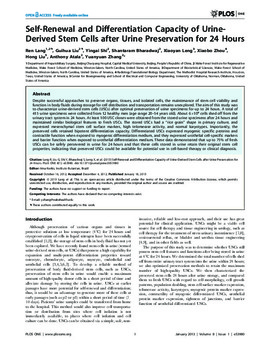| dc.contributor.author | Ren Lang | en_US |
| dc.contributor.author | Guihua Liu | en_US |
| dc.contributor.author | Yingai Shi | en_US |
| dc.contributor.author | Shantaram Bharadwaj | en_US |
| dc.contributor.author | Xiaoyan Leng | en_US |
| dc.contributor.author | Xiaobo Zhou | en_US |
| dc.contributor.author | Hong Liu | en_US |
| dc.contributor.author | Anthony Atala | en_US |
| dc.contributor.author | Yuanyuan Zhang | en_US |
| dc.date.accessioned | 2015-01-23T17:17:44Z | |
| dc.date.accessioned | 2016-03-30T15:36:24Z | |
| dc.date.available | 2015-01-23T17:17:44Z | |
| dc.date.available | 2016-03-30T15:36:24Z | |
| dc.date.issued | 2013-01-18 | en_US |
| dc.identifier.citation | Lang R, Liu G, Shi Y, Bharadwaj S, Leng X, et al. (2013) Self-Renewal and Differentiation Capacity of Urine-Derived Stem Cells after Urine Preservation for 24 Hours. PLoS ONE 8(1): e53980. doi:10.1371/journal.pone.0053980 | en_US |
| dc.identifier.uri | https://hdl.handle.net/11244/14090 | |
| dc.description | The authors would like to thank Karl-Erik Andersson for his valuable comments and Ms. Karen Klein (Research Support Core, Wake Forest School of Medicine) for her editorial assistance with this manuscript. | en_US |
| dc.description | Administrative support: AA. Editorial help: AA. Conceived and designed the experiments: YYZ. Performed the experiments: RL GL YS SB. Analyzed the data: RL GL YS SB XL XZ HL YYZ. Contributed reagents/materials/analysis tools: AA. Wrote the paper: RL GL YYZ. | en_US |
| dc.description.abstract | Despite successful approaches to preserve organs, tissues, and isolated cells, the maintenance of stem cell viability and function in body fluids during storage for cell distribution and transportation remains unexplored. The aim of this study was to characterize urine-derived stem cells (USCs) after optimal preservation of urine specimens for up to 24 hours. A total of 415 urine specimens were collected from 12 healthy men (age range 20–54 years old). About 6×104 cells shed off from the urinary tract system in 24 hours. At least 100 USC clones were obtained from the stored urine specimens after 24 hours and maintained similar biological features to fresh USCs. The stored USCs had a “rice grain” shape in primary culture, and expressed mesenchymal stem cell surface markers, high telomerase activity, and normal karyotypes. Importantly, the preserved cells retained bipotent differentiation capacity. Differentiated USCs expressed myogenic specific proteins and contractile function when exposed to myogenic differentiation medium, and they expressed urothelial cell-specific markers and barrier function when exposed to urothelial differentiation medium. These data demonstrated that up to 75% of fresh USCs can be safely persevered in urine for 24 hours and that these cells stored in urine retain their original stem cell properties, indicating that preserved USCs could be available for potential use in cell-based therapy or clinical diagnosis. | en_US |
| dc.language.iso | en_US | en_US |
| dc.publisher | PLos One | en_US |
| dc.relation.ispartofseries | PLoS ONE 8(1):e53980 | en_US |
| dc.relation.uri | http://www.plosone.org/article/info%3Adoi%2F10.1371%2Fjournal.pone.0053980 | en_US |
| dc.rights | Attribution 3.0 United States | en_US |
| dc.rights.uri | https://creativecommons.org/licenses/by/3.0/us/ | en_US |
| dc.subject | PLOS | en_US |
| dc.subject | Public Library of Science | en_US |
| dc.subject | Open Access | en_US |
| dc.subject | Open-Access | en_US |
| dc.subject | Science | en_US |
| dc.subject | Medicine | en_US |
| dc.subject | Biology | en_US |
| dc.subject | Research | en_US |
| dc.subject | Peer-review | en_US |
| dc.subject | Inclusive | en_US |
| dc.subject | Interdisciplinary | en_US |
| dc.subject | Ante-disciplinary | en_US |
| dc.subject | Physics | en_US |
| dc.subject | Chemistry | en_US |
| dc.subject | Engineering | en_US |
| dc.title | Self-Renewal and Differentiation Capacity of Urine-Derived Stem Cells after Urine Preservation for 24 Hours | en_US |
| dc.type | Research Article | en_US |
| dc.description.peerreview | Yes | en_US |
| dc.description.peerreviewnotes | http://www.plosone.org/static/editorial#peer | en_US |
| dc.identifier.doi | 10.1371/journal.pone.0053980 | en_US |
| dc.rights.requestable | false | en_US |

